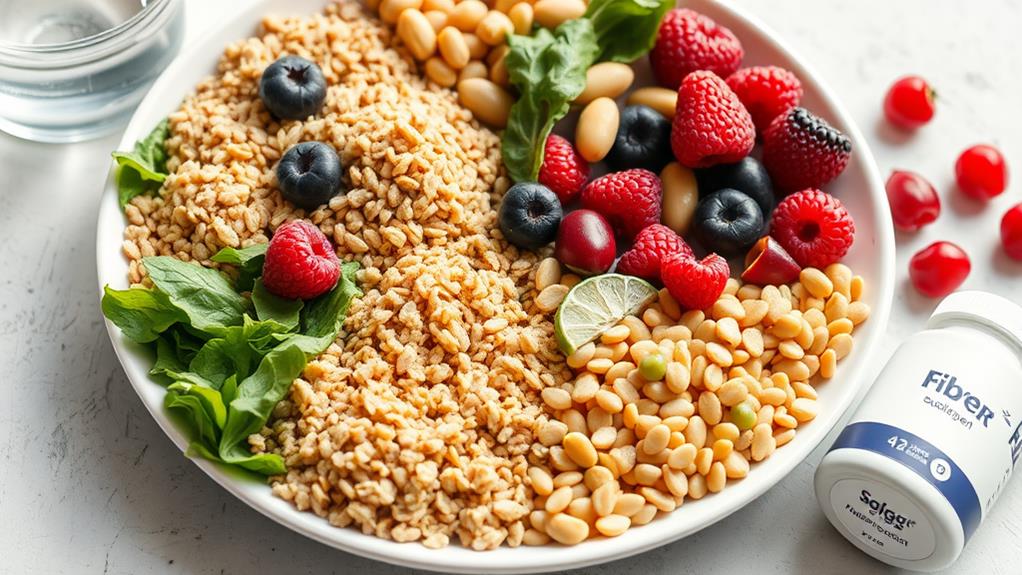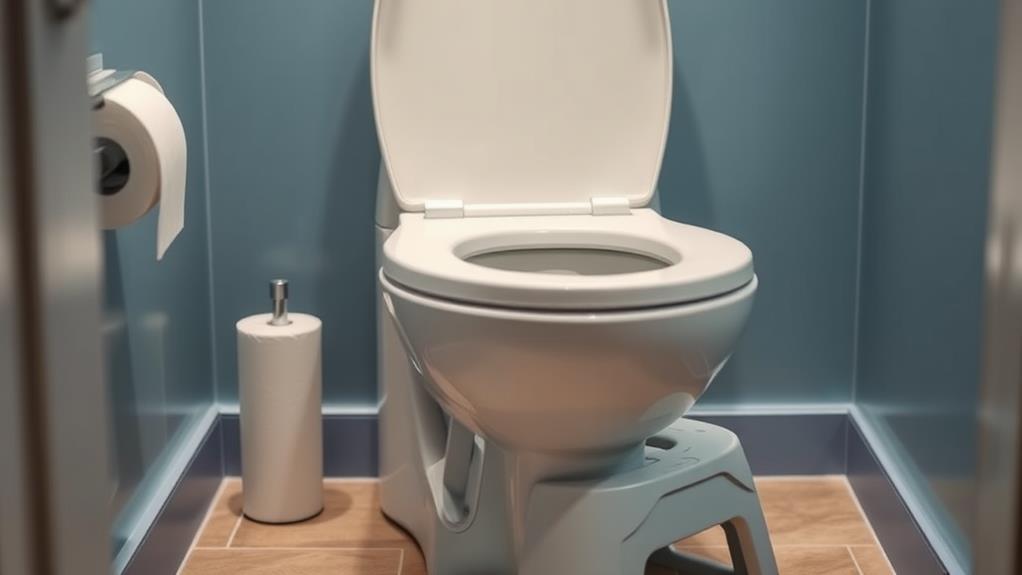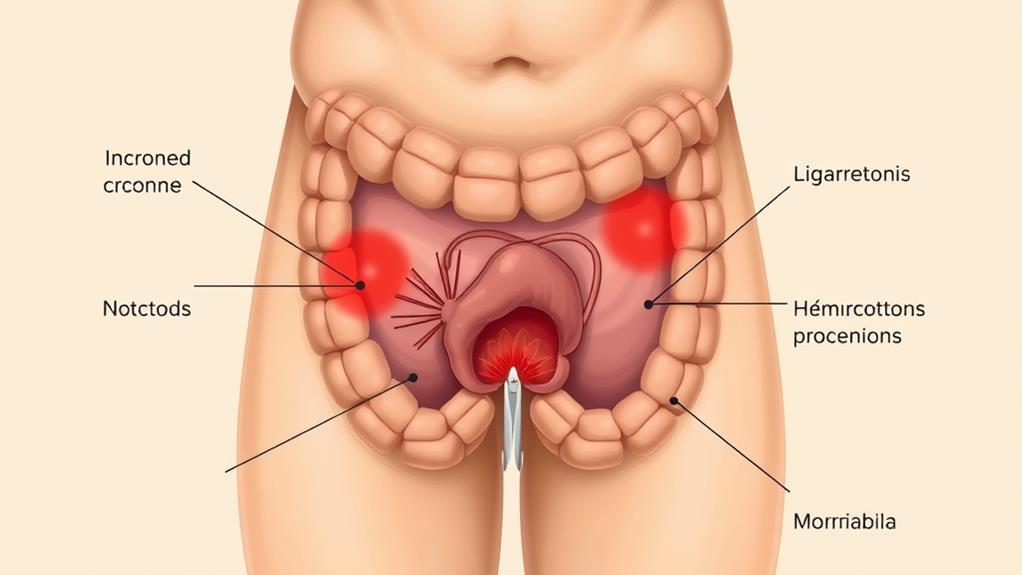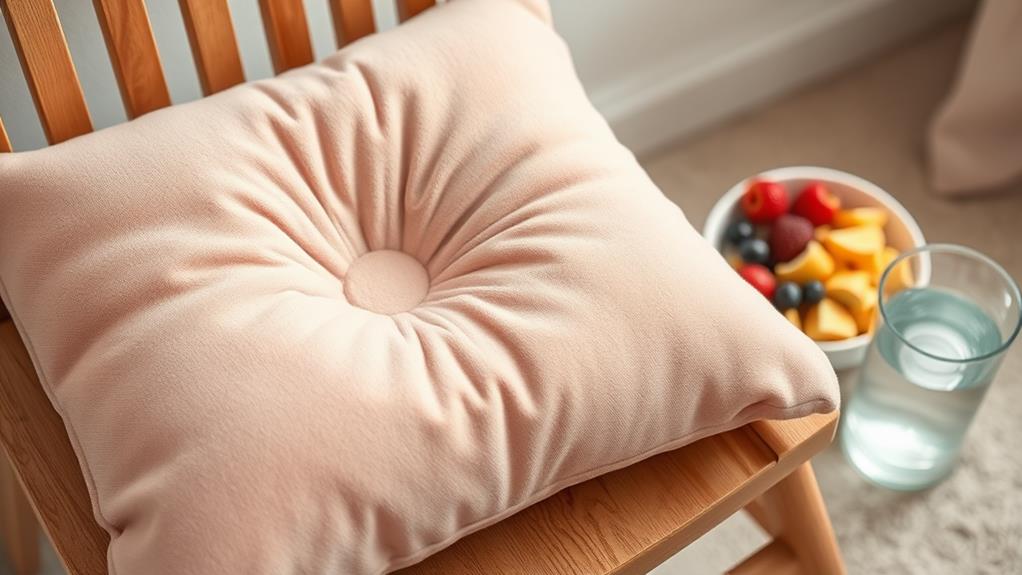As an Amazon Associate I earn from qualifying purchases.
Managing chronic hemorrhoids requires a multi-faceted approach for lasting relief. You'll need to make lifestyle changes, including adopting a high-fiber diet, staying hydrated, and exercising regularly. Proper bathroom habits, like limiting time on the toilet and using gentle wiping techniques, are vital. Stress reduction techniques can help alleviate symptoms, while topical treatments provide temporary relief. For persistent cases, non-invasive medical procedures or surgery may be necessary. Remember to consult your doctor for personalized advice. By implementing these strategies consistently, you'll be on your way to long-term hemorrhoid management and improved quality of life. Explore further to discover more in-depth solutions for your specific situation.
Dietary Changes for Symptom Control

When it comes to managing chronic hemorrhoids, making smart dietary changes can go a long way in controlling your symptoms. A high-fiber diet is key to alleviating hemorrhoid symptoms and reducing anal discomfort. By increasing your fiber intake to 25-35 grams per day, you can decrease bleeding from hemorrhoids by 50% and improve overall symptoms.
Focus on incorporating foods that are high in fiber, such as fruits, vegetables, whole grains, bran, oats, and barley. These foods help soften your stool and prevent constipation, a common cause of hemorrhoids. By reducing straining during bowel movements, you'll put less pressure on the veins in your rectum and anus, which can help prevent hemorrhoids from forming or worsening.
Don't forget to drink plenty of water – aim for 8-10 glasses daily. This helps the fiber move through your digestive system effectively, further preventing constipation. By adopting a diet low in fat and high in fiber, you'll be taking a proactive approach to managing your chronic hemorrhoids. Remember, consistency is key when it comes to dietary changes, so stick with it to see lasting improvements in your symptoms.
Exercise and Weight Management
While dietary changes play a vital role in managing chronic hemorrhoids, exercise and weight management are equally important factors. Regular physical activity can substantially reduce your risk of developing hemorrhoids and help manage existing ones. Studies show that men who exercise regularly have a 44% lower risk of hemorrhoids.
Exercise stimulates bowel function and improves digestive health, which is essential for preventing hemorrhoid flare-ups. Aim for at least 150 minutes of moderate-intensity aerobic exercise or 75 minutes of vigorous-intensity exercise per week. Activities like brisk walking, jogging, or cycling can be particularly beneficial.
Weight management is also critical, as excess weight puts additional pressure on the veins in the rectal area. By maintaining a healthy weight through exercise and proper nutrition, you'll reduce this pressure and lower your risk of hemorrhoids.
Don't forget to incorporate strength training exercises, especially those targeting the pelvic floor. These exercises can improve anal sphincter function, further reducing your risk of hemorrhoids. Remember, a well-rounded approach that combines dietary changes, regular exercise, and weight management is your best defense against chronic hemorrhoids and their associated discomfort.
Proper Bathroom Habits

Proper bathroom habits are essential for managing chronic hemorrhoids. You'll want to avoid prolonged sitting on the toilet, as this can increase pressure on your anal area. Instead, try to limit your bathroom time to no more than 5-10 minutes. When wiping, use soft, unscented toilet paper and be gentle to avoid irritating the sensitive tissue.
Increasing your fiber intake is pivotal for maintaining regular bowel movements. Aim for 25-30 grams of fiber per day through diet or a fiber supplement. Adequate fluid intake is also necessary to keep stools soft and easy to pass. Consider using a sitz bath with warm water for pain relief and to soothe the affected area after bowel movements.
Here's a quick guide to proper bathroom habits:
| Habit | Do | Don't |
|---|---|---|
| Sitting | Limit to 5-10 minutes | Avoid prolonged sitting |
| Wiping | Use soft, unscented paper | Don't use harsh or scented products |
| Diet | Increase fiber intake | Avoid low-fiber foods |
Stress Reduction Techniques
Several stress reduction techniques can substantially alleviate chronic hemorrhoid symptoms and promote overall digestive health. By practicing deep breathing, meditation, and yoga, you'll not only reduce your blood pressure but also encourage relaxation, which can help ease hemorrhoid discomfort. A study in the Journal of Clinical Gastroenterology found that stress management techniques effectively reduced symptoms of irritable bowel syndrome, a condition often linked to hemorrhoids.
Incorporating regular physical activity into your routine, such as walking or swimming, can play a vital role in reducing stress and promoting bowel regularity. This, in turn, helps prevent hemorrhoid flare-ups. Don't forget to take frequent breaks to stretch and move around, especially if you have a sedentary job. These short breaks can markedly reduce your sitting time, a known risk factor for developing hemorrhoids.
Lastly, prioritize getting adequate sleep, aiming for 7-8 hours nightly. Quality sleep helps regulate stress hormones and supports overall digestive health, which can prevent hemorrhoid symptoms from worsening. By implementing these stress reduction techniques, you'll be taking proactive steps towards managing your chronic hemorrhoids and improving your overall well-being.
Topical Treatments and Medications

When dealing with chronic hemorrhoids, you'll find various topical treatments available to alleviate your symptoms. Over-the-counter creams and ointments can provide temporary relief, while prescription-strength medications may be necessary for more severe cases. It's vital to understand proper application techniques to guarantee these treatments are as effective as possible in managing your condition.
Over-The-Counter Creams and Ointments
For those seeking relief from chronic hemorrhoids, over-the-counter creams and ointments can be a go-to solution. These topical treatments often contain ingredients designed to reduce pain, itching, and inflammation in the anal area. Hemorrhoid creams typically include pain relievers like lidocaine or hydrocortisone, which help alleviate discomfort and swelling.
You'll find many options containing witch hazel, a natural astringent that can help relieve hemorrhoid symptoms by shrinking swollen blood vessels. When applying these products, follow the instructions carefully and avoid overuse, as prolonged application may lead to skin irritation.
To enhance the effectiveness of over-the-counter treatments, combine them with other self-care methods like sitz baths. Soaking in warm water for 10-15 minutes can soothe the affected area and improve blood circulation.
While these creams and ointments can provide temporary relief, they're not a long-term solution for chronic hemorrhoids. If your symptoms persist or worsen after a week of treatment, consult your healthcare provider. They may recommend prescription-strength medications or other interventions to address your specific condition and provide lasting relief.
Prescription-Strength Topical Medications
Prescription-strength topical medications offer a more potent solution for those struggling with chronic hemorrhoids. These treatments can effectively reduce inflammation, relieve itching, and numb the affected area, providing temporary relief from hemorrhoid symptoms.
Hydrocortisone creams, available in strengths up to 2.5%, can be applied up to four times daily to reduce inflammation and itching. However, you shouldn't use them for more than a week to avoid skin thinning. Lidocaine creams or ointments can help numb the area when applied 10-15 minutes before a bowel movement, reducing discomfort and pain.
For more targeted relief, your doctor may prescribe nifedipine ointment. Applied three times a day, it can reduce anal pressure and relieve pain associated with hemorrhoids. Another option is topical nitrates, such as nitroglycerin ointment, which help relax the anal sphincter muscle, further reducing pain and pressure.
These prescription-strength topical medications provide a range of options for managing chronic hemorrhoids. By targeting specific symptoms and underlying causes, they can offer more effective relief than over-the-counter alternatives. Always follow your doctor's instructions when using these medications to guarantee safe and effective treatment.
Proper Application Techniques
Proper application of topical treatments and medications is key to maximizing their effectiveness in managing chronic hemorrhoids. When using topical creams or suppositories containing ingredients like witch hazel or hydrocortisone, you'll find relief from hemorrhoid symptoms such as itching, pain, and inflammation.
To apply these treatments effectively, start by washing your hands thoroughly. Gently pat the affected area dry with a clean towel to minimize irritation. For creams, apply a small amount to the affected area 2-3 times daily, or as directed. When using suppositories, lie on your side with your knees bent. Insert the suppository into the rectum and remain in this position for 15-30 minutes to allow the medication to dissolve and take effect.
Combine topical treatments with other conservative management strategies like fiber supplements and warm baths to enhance their effectiveness. Always follow the specific instructions provided with your medication and consult your healthcare provider if you experience any adverse reactions or if your symptoms worsen or persist. By applying these techniques consistently, you'll optimize your treatment and improve your chances of finding lasting relief from chronic hemorrhoids.
Non-Invasive Medical Procedures
Relief from chronic hemorrhoids doesn't always require surgery. Non-invasive medical procedures offer effective options for managing persistent symptoms. These minimally invasive techniques can provide lasting relief for internal hemorrhoids, including symptomatic grade III and bleeding internal hemorrhoids.
Several non-invasive medical procedures are available to treat chronic hemorrhoids:
| Procedure | Method | Target |
|---|---|---|
| Rubber band ligation | Cuts off blood supply | Small to large internal hemorrhoids |
| Sclerotherapy | Injects shrinking solution | Small to medium internal hemorrhoids |
| Infrared coagulation | Uses infrared light | Small to medium internal hemorrhoids |
Rubber band ligation is a common technique where a small band is placed around the base of the hemorrhoid, cutting off its blood supply and causing it to shrink. Sclerotherapy involves injecting a solution directly into the hemorrhoid to reduce its size. Infrared coagulation and electrocoagulation use heat from infrared light or electric current, respectively, to shrink the hemorrhoid.
These non-invasive medical procedures have shown impressive success rates, with up to 80% of patients experiencing significant symptom relief. They're particularly effective for treating rectal bleeding and other persistent symptoms associated with chronic hemorrhoids. Your doctor can help determine which procedure is best suited for your specific condition.
Surgical Options for Severe Cases

When non-invasive treatments fail, you might need to ponder surgical options for your chronic hemorrhoids. Two common procedures are hemorrhoidectomy, which removes the hemorrhoids entirely, and stapled hemorrhoidopexy, which repositions the hemorrhoidal tissue. It's vital to weigh the pros and cons of each method and understand what to expect during your post-surgery recovery before making a decision.
Hemorrhoidectomy: Pros and Cons
Hemorrhoidectomy stands as a surgical solution for severe, chronic hemorrhoids that haven't responded to conservative treatments. This procedure involves removing the hemorrhoidal tissue, offering long-term relief for patients with grade IV hemorrhoids. While effective, it's important to weigh the pros and cons before opting for this surgery.
On the positive side, hemorrhoidectomy provides a permanent solution, substantially reducing pain and bleeding associated with chronic hemorrhoids. It's particularly beneficial for severe cases that haven't improved with other treatments. However, the procedure comes with its drawbacks. Postoperative pain can be intense, requiring strong pain management for several days or weeks. The complication rate, though generally low, includes risks such as infection, urinary retention, and anal stricture.
In recent years, alternative surgical techniques like stapled hemorrhoidopexy have emerged, promising less pain and faster recovery. However, traditional hemorrhoidectomy remains the gold standard for severe cases. It's typically performed under general anesthesia, which carries its own risks. While the surgery itself is relatively quick, recovery can be lengthy, with most patients experiencing decreased pain and returning to normal activities within 2-3 weeks.
Stapled Hemorrhoidopexy Procedure
Stapled hemorrhoidopexy has emerged as an innovative surgical option for patients with severe internal hemorrhoids. This procedure uses a specialized stapling device to reposition hemorrhoidal tissue and cut off its blood supply, effectively treating persistent symptoms like bleeding and pain in the anal canal.
If you've tried non-surgical treatments like rubber band ligation without success, your doctor may recommend stapled hemorrhoidopexy. The procedure is typically performed under general anesthesia and takes 30-60 minutes to complete. One of the main advantages of this hemorrhoid treatment is its lower postoperative pain rate and faster recovery time compared to traditional hemorrhoidectomy.
Stapled hemorrhoidopexy boasts a high success rate, with 80-90% of patients experiencing significant symptom relief and improved quality of life after the procedure. However, bear in mind that this treatment is specifically designed for internal hemorrhoids and may not be suitable for external hemorrhoids or mixed hemorrhoidal disease.
As with any surgical intervention, there's a risk of postoperative complications. However, the overall benefits of stapled hemorrhoidopexy make it an attractive option for those seeking long-term relief from chronic internal hemorrhoids that haven't responded to conservative treatments.
Post-Surgery Recovery Expectations
The road to recovery after hemorrhoid surgery can be challenging, but understanding what to expect can help you prepare for the journey ahead. Following a hemorrhoidectomy, you'll typically need a 1-2 week recovery period. During this time, you may experience pain, bleeding, and urinary retention. Your doctor will prescribe a pain management plan, which often includes oral medications, topical creams, and warm sitz baths to reduce discomfort and inflammation.
It's vital to avoid heavy lifting, bending, or straining for 2-4 weeks post-surgery to promote healing and minimize discomfort. You'll need to follow a high-fiber diet and stay hydrated to prevent constipation and encourage regular bowel movements, reducing the risk of complications.
If you've undergone a stapled hemorrhoidopexy, you may experience less pain and a faster recovery compared to traditional hemorrhoidectomy. However, regardless of the procedure, it is imperative to follow your doctor's instructions carefully. Be patient with your body as it heals, and don't hesitate to contact your healthcare provider if you have concerns during your recovery period. With proper care and attention, you'll be on your way to lasting relief from chronic hemorrhoids.
Frequently Asked Questions
How Do You Get Permanent Relief From Hemorrhoids?
To get permanent relief from hemorrhoids, you'll need a combination approach. Consider hemorrhoid surgery for severe cases. Manage pain, make lifestyle changes, and adjust your diet. Try natural remedies like witch hazel, sitz baths, and herbal supplements. Exercise and reduce stress.
How I Cured My Chronic Hemorrhoids?
You've likely faced personal struggles with hemorrhoid triggers. Through diet overhauls, pain management, and lifestyle changes, you've found relief. Natural remedies, doctor visits, and symptom tracking helped you overcome embarrassing moments and establish new daily routines for healing.
What Can You Use Long Term for Hemorrhoids?
You can use topical creams with witch hazel, apply cold compresses, take sitz baths, and use fiber supplements long-term for hemorrhoids. Dietary changes, lifestyle modifications, and natural therapies like herbal remedies also offer lasting relief for your condition.
How to Reverse Internal Hemorrhoids?
To reverse internal hemorrhoids, you'll need to make dietary changes, increase fiber intake, and maintain a healthy weight. Try herbal remedies, colon cleanses, and probiotic supplements. Use sitz baths, witch hazel, cold compresses, and topical creams for relief.
Conclusion
You've got a range of strategies to manage chronic hemorrhoids long-term. While it might seem overwhelming to make lifestyle changes, they're vital for lasting relief. Don't let the fear of discomfort hold you back from seeking treatment. Remember, even small adjustments can make a big difference. From diet tweaks to stress reduction, there's a solution that'll work for you. If conservative methods aren't enough, don't hesitate to explore medical procedures. Your comfort and quality of life are worth it.
Amazon and the Amazon logo are trademarks of Amazon.com, Inc, or its affiliates.
